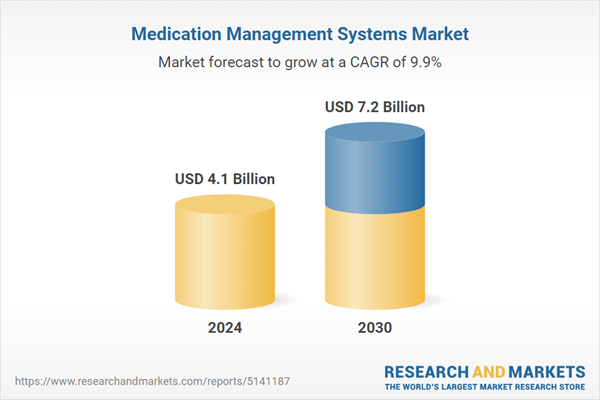Global Medication Management Systems Market - Key Trends & Drivers Summarized
What Are Medication Management Systems and Why Are They Essential?
Medication management systems encompass a range of tools and technologies designed to ensure the safe, effective, and efficient administration and monitoring of medications. These systems play a crucial role in healthcare settings by reducing medication errors, improving patient outcomes, and enhancing overall healthcare efficiency. As the population ages and chronic disease prevalence increases, the demand for sophisticated medication management solutions has surged. Innovations such as automated dispensing machines, electronic medication administration records, and smart pillboxes are transforming how medications are prescribed, dispensed, and tracked, aligning with the broader push towards digital healthcare.How Is Regulatory Compliance Shaping the Market?
Regulatory compliance is a significant driver in the medication management systems market. Governments and healthcare organizations worldwide are imposing stringent regulations to ensure patient safety and reduce healthcare costs associated with medication errors. These regulations mandate the adoption of advanced management systems in hospitals and pharmacies. As a result, healthcare providers are increasingly investing in integrated technologies that not only comply with these regulations but also streamline workflows and improve patient care quality.What Role Does Technology Play in Advancing Medication Management?
Technology is at the heart of the evolution of medication management systems. The integration of artificial intelligence (AI) and machine learning algorithms is particularly transformative, enabling predictive analytics that can anticipate potential adverse drug interactions and optimize medication regimens. Mobile health applications and telemedicine platforms are extending the reach of these systems, facilitating remote monitoring and management of patient medication routines. Moreover, blockchain technology is emerging as a solution to secure drug supply chains and enhance the traceability of medications, ensuring authenticity and minimizing the risk of counterfeit drugs.What Drives the Growth in the Medication Management Systems Market?
The growth in the medication management systems market is driven by several factors including the increasing burden of chronic diseases, the need for reducing medication errors, and the shift towards personalized medicine. The growing elderly population, who often require complex medication regimes, further accelerates the demand for effective management solutions. Additionally, advancements in IT infrastructure and the expansion of healthcare services in developing countries are creating new opportunities for market expansion. The rising focus on cost containment in healthcare and the substantial investments in health tech startups are also contributing to the dynamic growth of this market, underscoring a global movement towards more integrated and technology-driven healthcare solutions.Report Scope
The report analyzes the Medication Management Systems market, presented in terms of market value (USD). The analysis covers the key segments and geographic regions outlined below.- Segments: Type (Inventory Management Solutions, Clinical Decision Support System Solutions, Computerized Physician Order Entry (CPOE), Electronic Medication Administration Record, Other Types); End-Use (Hospitals, Pharmacies, Other End-Uses).
- Geographic Regions/Countries: World; United States; Canada; Japan; China; Europe (France; Germany; Italy; United Kingdom; and Rest of Europe); Asia-Pacific; Rest of World.
Key Insights:
- Market Growth: Understand the significant growth trajectory of the Inventory Management Solutions segment, which is expected to reach US$2.2 Billion by 2030 with a CAGR of 8.4%. The Clinical Decision Support System Solutions segment is also set to grow at 11.4% CAGR over the analysis period.
- Regional Analysis: Gain insights into the U.S. market, valued at $1.2 Billion in 2024, and China, forecasted to grow at an impressive 9.4% CAGR to reach $1.1 Billion by 2030. Discover growth trends in other key regions, including Japan, Canada, Germany, and the Asia-Pacific.
Why You Should Buy This Report:
- Detailed Market Analysis: Access a thorough analysis of the Global Medication Management Systems Market, covering all major geographic regions and market segments.
- Competitive Insights: Get an overview of the competitive landscape, including the market presence of major players across different geographies.
- Future Trends and Drivers: Understand the key trends and drivers shaping the future of the Global Medication Management Systems Market.
- Actionable Insights: Benefit from actionable insights that can help you identify new revenue opportunities and make strategic business decisions.
Key Questions Answered:
- How is the Global Medication Management Systems Market expected to evolve by 2030?
- What are the main drivers and restraints affecting the market?
- Which market segments will grow the most over the forecast period?
- How will market shares for different regions and segments change by 2030?
- Who are the leading players in the market, and what are their prospects?
Report Features:
- Comprehensive Market Data: Independent analysis of annual sales and market forecasts in US$ Million from 2024 to 2030.
- In-Depth Regional Analysis: Detailed insights into key markets, including the U.S., China, Japan, Canada, Europe, Asia-Pacific, Latin America, Middle East, and Africa.
- Company Profiles: Coverage of players such as Allscripts Healthcare Solutions, Inc., CareFusion Corporation, Cerner Corporation, GE Healthcare, McKesson Corporation and more.
- Complimentary Updates: Receive free report updates for one year to keep you informed of the latest market developments.
Some of the 22 companies featured in this Medication Management Systems market report include:
- Allscripts Healthcare Solutions, Inc.
- CareFusion Corporation
- Cerner Corporation
- GE Healthcare
- McKesson Corporation
- MEDITECH
- Omnicell, Inc.
- Optum, Inc.
- QuadraMed Corporation
- Siemens Healthineers
This edition integrates the latest global trade and economic shifts into comprehensive market analysis. Key updates include:
- Tariff and Trade Impact: Insights into global tariff negotiations across 180+ countries, with analysis of supply chain turbulence, sourcing disruptions, and geographic realignment. Special focus on 2025 as a pivotal year for trade tensions, including updated perspectives on the Trump-era tariffs.
- Adjusted Forecasts and Analytics: Revised global and regional market forecasts through 2030, incorporating tariff effects, economic uncertainty, and structural changes in globalization. Includes historical analysis from 2015 to 2023.
- Strategic Market Dynamics: Evaluation of revised market prospects, regional outlooks, and key economic indicators such as population and urbanization trends.
- Innovation & Technology Trends: Latest developments in product and process innovation, emerging technologies, and key industry drivers shaping the competitive landscape.
- Competitive Intelligence: Updated global market share estimates for 2025, competitive positioning of major players (Strong/Active/Niche/Trivial), and refined focus on leading global brands and core players.
- Expert Insight & Commentary: Strategic analysis from economists, trade experts, and domain specialists to contextualize market shifts and identify emerging opportunities.
Table of Contents
Companies Mentioned (Partial List)
A selection of companies mentioned in this report includes, but is not limited to:
- Allscripts Healthcare Solutions, Inc.
- CareFusion Corporation
- Cerner Corporation
- GE Healthcare
- McKesson Corporation
- MEDITECH
- Omnicell, Inc.
- Optum, Inc.
- QuadraMed Corporation
- Siemens Healthineers
Table Information
| Report Attribute | Details |
|---|---|
| No. of Pages | 184 |
| Published | October 2025 |
| Forecast Period | 2024 - 2030 |
| Estimated Market Value ( USD | $ 4.1 Billion |
| Forecasted Market Value ( USD | $ 7.2 Billion |
| Compound Annual Growth Rate | 9.9% |
| Regions Covered | Global |









